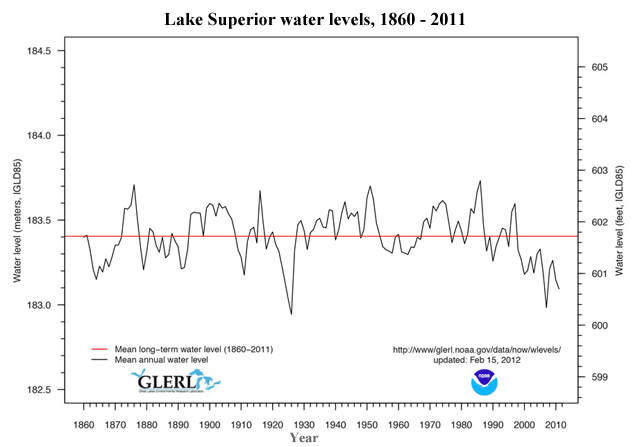Great Lakes Ice Cover Down 71% Since 1973

Figure 1. A tale of two winters: Lake Superior was choked with ice at the end of the winter of 2008 – 2009 (top), but was virtually ice-free at the end of the winter of 2011 – 2012 (bottom.)
Ice cover on North America’s Great Lakes–Superior, Michigan, Huron, Ontario, and Erie–has declined 71% since 1973, says a new study published in the Journal of Climate by researchers at NOAA’s Great Lakes Environmental Research Laboratory.
The biggest loser of ice during the 1973 – 2010 time period was Lake Ontario, which saw an 88% decline in ice cover. During the same time period, Superior lost 79% of its ice, Michigan lost 77%, Huron lost 62%, and Erie lost 50%. The loss of ice is due to warming of the lake waters. Winter air temperatures over the lower Great Lake increased by about 2.7°F (1.5°C) from 1973 – 2010, and by 4 – 5°F (2.3 – 2.7°C) over the northern Lakes, including Lake Superior. Lake Superior’s summer surface water temperature warmed 4.5°F (2.5°C) over the period 1979 – 2006 (Austin and Colman 2007).
During the same period, Lake Michigan warmed by about 3.3°F (1.7°C), Lake Huron by 4.3°F (2.4°C), and Lake Erie showed almost no warming. The amount of warming of the waters in Lakes Superior, Huron, and Michigan is higher than one might expect, because of a process called the ice-albedo feedback: when ice melts, it exposes darker water, which absorbs more sunlight, warming the water, forcing even more ice to melt. This sort of vicious cycle is also responsible for the recent extreme loss of Arctic sea ice. The increase in temperature of the lakes could be due to a combination of global warming and natural cycles, the researchers said. They noted a pronounced 4-year and 8-year oscillation in ice coverage, which could be caused by the El Ninño/La Niña and Arctic Oscillation (AO), respectively.
The consequences of Great Lakes ice loss
Ice coverage on the Great Lakes was just 5% this past winter, the second lowest on record, behind 2002. The lack of Great Lakes ice this winter probably added a few degrees of warmth to the unprecedented “Summer in March” conditions observed in Michigan last week–an event the National Weather Service in Detroit called “perhaps the most anomalous weather event in Michigan since climate records began 130 years ago.” We can anticipate that areas surrounding the Great Lakes will see an increased incidence of warm spring weather due to decreased ice cover on the lakes.
The loss of Great Lakes ice has allowed much more water to evaporate in winter, resulting in heavier lake effect snow near the shore, and lower lake levels. Lower water levels have had a significant impact on the Great Lakes economy. Over 200 million tons of cargo are shipped every year through the Great Lakes. Since 1998, when water levels took a severe drop, commercial ships were forced to light-load their vessels. For every inch of clearance that these oceangoing vessels lost because of low water levels, $11,000 – $22,000 in profits were lost per day. Hydropower plants have also been affected by low water levels; several New York and Michigan plants were run at reduced capacity, forcing them to buy higher priced energy from other sources, and passing on the higher costs to consumers.
The large loss of ice is also likely to accelerate shoreline erosion because of the increase in open water, and promote more algal blooms. It is uncertain if the Great Lake water levels will continue to fall as the climate warms, since the region is expected to see an increase in precipitation over the coming decades. In Michigan, annual precipitation increased by about 14% between 1895 – 2011, according to the National Climatic Data Center.

Figure 2. Great Lakes ice coverage for the period December 4 – March 5, from the winter of 1980 – 1981 through 2011 – 2012. The winter of 2011 – 2012 had the second lowest ice coverage on record, just 5%. Only 2001 – 2002 (4.5%) had lower ice cover. The median ice coverage between 1980 – 2011 was about 19%.

Figure 3. Water levels on Lake Superior between 1860 and February 2012. Since the late 1990s, water levels have seen a steep decline, due to the loss of ice cover allowing more evaporation.
You can return to the main Market News page, or press the Back button on your browser.

